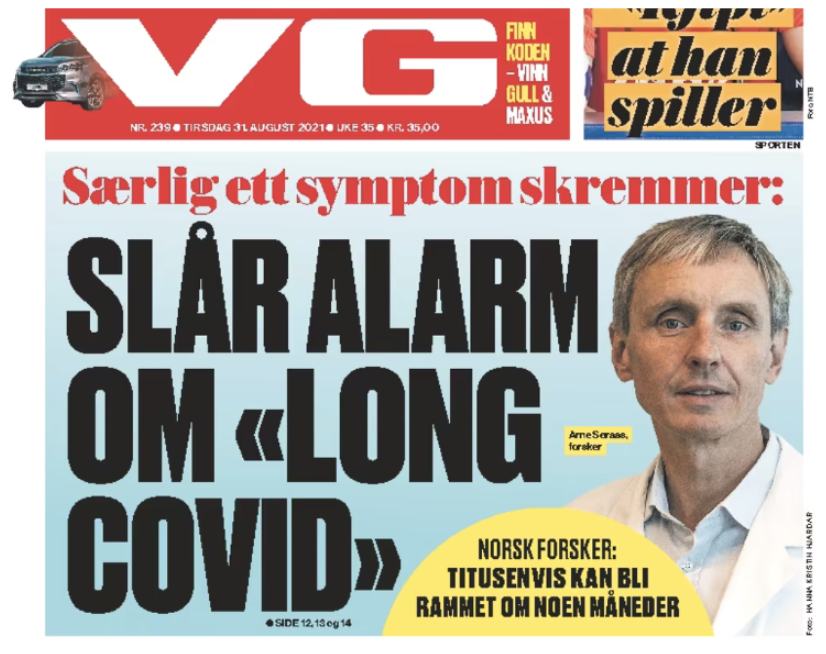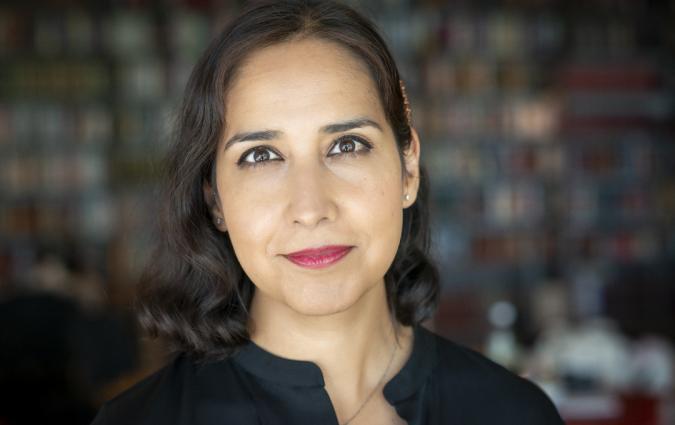In this piece
Empathetic verification: how did Norwegian newsrooms cover ‘Long COVID’?

A patient suffering from Long COVID is examined. REUTERS/Amir Cohen
In this piece
What is Long COVID? What isn’t it? | Two years, 129 articles | Where are the immigrants? | Invisible verification | He said, she said: two Long COVID tales | Journalists in the middle | Can you question lived experience? | Reducing the patient-expert divide | Conclusion“Tens of thousands might be affected in a few months.” These were the words of a Norwegian Long COVID researcher – an ominous subheading on the front page of Verdens Gang (VG), Norway’s largest newspaper, in August 2021.
The acute COVID-19 pandemic was receding in Norway, restrictions were being lifted as summer weather and vaccinations led to falling hospitalisation rates and fewer deaths. It could have been a bright moment, but the front page told a different story: don’t let your guard down; the danger is still out there.

In Norway, journalists began asking about the possible long-term effects of COVID-19 before the coronavirus even properly took hold in the country. The first article mentioning long-term effects appeared on the website of NRK, the national broadcaster, on March 6, 2020, a week before the first national lockdown.
Patients, doctors, researchers and journalists have all been trying to understand Long COVID in real time, as the condition has emerged. And so it is important to reflect on our reporting: what kinds of stories have we told about Long COVID? How did we listen to patients and to experts, how did we frame them?
During my time at the Reuters Institute I studied the output of three large Norwegian media outlets – Aftenposten, VG and NRK’s online edition – between January 2020 and March 2022, gathering 129 articles that made mention of Long COVID.
My goal was not to critique newsroom choices made in an extraordinary situation, but to learn from them.
What is Long COVID? What isn’t it?
For most of the pandemic, Long COVID didn’t officially exist. It wasn’t until October 2021 that the condition was given a description and an official name by the World Health Organisation (WHO). It’s still a broad definition: it covers both months-long debilitating illness and “a high number of post-viral fatigue cases that appear to resolve spontaneously”, according to a review by the British National Institute for Health Research.
Estimates on how common Long COVID is vary wildly: from less than 10% of COVID sufferers in some studies – or less for some groups, like children – to more than half in others. So the first challenge for journalists has been simply: what are we talking about?
First, there are persistent symptoms for those who got seriously ill from COVID-19, and who spent time in hospital or in intensive care units (ICU). While medical professionals and researchers have long known that such treatment can create long-term effects, it hasn’t been that well-known in the general population.
Second, you have long-term symptoms in people who never got really sick: those who had some days of fever, or a cough for a while – but then the symptoms never went away, or reappeared. That’s been a big surprise, said Tine Dommerud, a health journalist at Aftenposten: “It’s easier to understand those who got really ill from COVID, and who still have problems with breathing or exertion or the like.”.
Kristin Hofsø, an intensive care nurse and Long COVID researcher with Oslo University Hospital, thinks the term “Long COVID” has been used too liberally by the media. In particular, she points to the fact that three different things have often been confused:
- Acute COVID symptoms.
- Residual symptoms (“It’s not uncommon to be coughing two months after a virus infection”, said Hofsø.)
- True long-term effects, or Long COVID.
“The term wasn’t defined, so what are we talking about? It has been anything from two weeks after the onset of disease to six months,” said Hosfø. Including all of this under the Long COVID umbrella can have contributed to a sense of uncertainty: “It was all very un-nuanced; we started talking about Long COVID practically a day after people had been sick. And people were terrified,” said Hofsø.
Two years, 129 articles
Between January 2020 and March 2022, the three large Norwegian media outlets Aftenposten, VG and NRK’s online edition published (at least) 129 articles about or mentioning Long COVID. The stories reveal some interesting patterns in how we’ve reported on Long COVID:
- More than a third – 36% – of Long COVID articles featured a patient narrative or a “case” (the term used in Norwegian): a meeting with someone who is struggling with long-term effects after being sick.
- Long COVID is more commonly reported by women. And yet, 53% of the patients featured in Norwegian Long COVID stories were men.
- Of the patients featured in these stories, 60% were suffering from Long COVID after having a mild case of COVID – they were never in hospital.
- 85 different symptoms have been linked to Long COVID by patients, researchers or other sources.
- Only once has a journalist followed up with a patient: the patient was getting married – he had proposed while hospitalised – and NRK covered the wedding. Otherwise, we don’t know what happened to these patients. Did they get better? Still struggling? As of this writing, the reporting doesn’t say.
Where are the immigrants?
Long COVID sufferers, as portrayed by these three outlets, are white Norwegians: 41 out of the 46 Norwegian Long COVID patients profiled in these articles were ethnic majority Norwegians (as identified by photos and by names like Ingrid, Svein, Åse).
That’s 89.1% representation for 83% of the population. Contrast that with the fact that people with immigrant backgrounds were almost three times as likely to get infected by the coronavirus and almost four times as likely to end up in hospital. Why aren’t journalists talking to them?
The journalists I’ve interviewed describe it as a structural problem: fewer in immigrant communities read the paper, and so they are less likely to contact the paper if they have a story that ought to be reported. Fewer might think it natural to run an obituary, and so deaths are less visible. And Norwegian journalists have fewer sources in these communities. Building relationships and gaining access to under-represented minority communities doesn’t happen easily during a crisis. That means the work of avoiding the same under-representation during the next crisis should start now.
Invisible verification
From reading these newspaper articles, it appears journalists rarely probe the stories told by the patients they encounter. In all of the 129 articles, only two VG reporters explicitly mention in writing that they’ve seen medical records which confirm the diagnosis and medical history. However, in interviews, journalists recount the careful vetting that goes into selecting a “case” for such an article: Dommerud underlined how she never interviews a patient without getting a release, so that she can talk to their doctor without breaking patient-doctor confidentiality.
It is worth considering whether including this type of verification work in the final article could help increase the perceived trustworthiness of the reporting – and of the patient’s story.
He said, she said: two Long COVID tales
There aren’t many Long COVID researchers in Norway, but those who do study this disease have been interviewed repeatedly. And the roles that they have taken in the public have ended up clearly influencing the coverage.
Arne Søraas is the leader of the Norwegian Corona Study, a large survey which has tracked infections and self-reported health since the summer of 2020. Søraas has been one of the clearest voices of warning in the Norwegian press: the quote at the start of this essay, about how thousands might catch Long COVID, is his.
Søraas was initially not aware of the possibility of Long COVID, he said in our interview – a question about long-term health made it into their survey because a patient representative on their advisory board asked for it.
Kristin Hofsø, on the other hand, is an intensive care nurse and researcher who started looking into Long COVID because she had seen people suffer long-term effects after hospitalisation in previous disease outbreaks: “I expected this very early on”, she said. Hofsø has been critical of the coverage of Long COVID. “Fatigue after a virus infection isn’t uncommon,” she told VG in March 2021.
These different starting points might explain why the two experts, looking at the same pandemic, tell such different stories. Hofsø thought that a viral lung infection might cause long-term effects for some patients, and so she wasn’t shocked or particularly frightened when these started appearing.
Søraas, on the other hand, was not expecting Long COVID. He was surprised, he said during our interview, by the fact that questions about long-term effects were in the press as early as March 2020, and he was surprised by the type of symptoms patients were reporting: a persistent cough seemed likely, Søraas said, but people were reporting problems like brain fog. Thus, he has been focused on making the public aware of the uncertainties and risks: “We have no idea what the long-term damages after COVID will be, because it’s only been around for two years.”
Journalists in the middle
When medical experts have such different views, it becomes challenging for journalists to cover a topic like Long COVID: to whom do you listen? Who do you call for a comment or explanation?
I interviewed one journalist from each of the three newsrooms whose work I analysed, and the conversations reflected the two perspectives that Hofsø and Søraas raised.
Paal Wergeland from NRK, for example, said his journalistic efforts had been mainly focused on those who do develop Long COVID. Others wanted to focus more on the majority who don’t develop COVID, and a desire not to scare them unnecessarily. “I have the utmost respect for the fact that many become really sick. But I also have respect for the idea of a self-fulfilling prophecy – so we think carefully about this coverage,” said Tine Dommerud, the Aftenposten health reporter.
It is interesting that these perspectives mirror who the journalists met first in their work on this topic: Wergeland had his first introduction to Long COVID through an interview with Arne Søraas, whereas Dommerud and Marie Golimo Kingsrød from VG first talked about it with other researchers who’ve been more focused on the risk of creating fear. Kingsrød was even warned by a researcher, early in the pandemic: “The more you write about Long COVID, the more Long COVID there will be.”
So how to navigate and present these different perspectives? The main tools, my interviewees said, are the basic ones: Knowledge, and multiple sources.
Although many articles published by these outlets have included interviews with multiple sources, you have to be an attentive reader to catch this ongoing debate among Long COVID researchers: only three out of 23 articles where Long COVID researchers have been interviewed have included more than one.
The differing viewpoints become clear if you follow the coverage closely and over time, but it is hard to say if they would come across for a casual reader.
Can you question lived experience?
In July 2020, VG interviewed a Swedish woman, Åsa Hedlund. She had been sick with COVID some months back, but she was still struggling. Hedlund listed a lot of different symptoms: fever, chest pain, a stomach ache, burning skin, racing heart, shakes, back pain, swelling, diarrhoea. She had problems getting enough oxygen and problems concentrating.
Hedlund’s story came to mind during my interview with Marie Kingsrød from VG. Kingsrød was talking about an uncomfortable voice in the back of her head when she first started reading about Long COVID in international media: “Is it real? I mean, you don’t want to think that, but is it all in their heads?”
Long COVID is a disease without a clearly defined list of symptoms, or an easy explanation, and the patient might not have external “proof” that the coronavirus was the origin of their problems. To be clear, neither Kingsrød nor any of the journalists or researchers I’ve interviewed have indicated that they don’t believe Long COVID is real. But a journalist should seek the truth and verify claims. So can you question a patient’s lived experience in the way that you can – and should – probe statements from doctors, politicians or researchers? How do you go about seeking verification on a couch in Hedlund’s living room, while also listening to what her life has been like while ill?
In short: How do you balance an empathetic presence with the need for journalistic verification?
Reducing the patient-expert divide
When this part of the journalistic process becomes fraught, I believe a core issue is the way we frame patient narratives, or “cases”. Too often patients are cast as “the humanising angle” – there to fill a specific, experiential role.
This is reflected in research on patient narratives – or exemplars, as they’re often called in the scientific literature. A few years ago, a group of American researchers interviewed journalists about this topic, and concluded that “journalists select exemplars to serve the purposes of informing, connecting, and getting attention.” But, they continue, journalists believe patients are less important for “aiding audience understanding”, compared with experts, data and statistics.
It is worth asking whether this attitude can and should be challenged. Giving the patient an active role in the article, presenting them as someone the other sources talk with, is different from having them be the object that politicians and researchers talk about.
There are multiple strategies that a journalist can use while working on a story to try to reduce the patients-expert divide: tell the patient to expect difficult questions, let them explain their reasoning (asking not “are you sure it’s caused by COVID-19”, but “why do you think it’s caused by COVID-19”), and give them any opportunity to respond when a scientist contradicts their experience.
Conclusion
During the first two years of the coronavirus pandemic, Long COVID changed from being a scary possibility to a real phenomenon – and a real challenge for journalists.
The jury is still out on almost every question: how prevalent is Long COVID, and why does it affect people in such different ways? What degree of long-term effects are to be expected, and how much is too much?
Navigating disagreements between different experts – and between experts and other types of sources – will be a challenge for journalists for years to come. With contested illnesses like Long COVID, there is an inherent tension between the journalistic need for empathetic listening and verification. The point is not to resolve the tension, but to face it head on.




